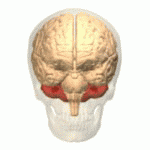Cerebellum / little brain

The cerebellum or 'little brain' is located on the skull base under the large brains and behind the brainstem. The cerebellum is relatively well protected from trauma in comparison to the frontal and temporal lobes and the brainstem.
The cerebellum is involved in the coordination of movement, balance and equilibrium and muscle tone. But also in a large number of cognitive, linguistic and emotional functions. *
Ataxia
An ataxia is a failure of muscle control in the arms and legs that result in movement disorders, a lack of balance and coordination or a disturbance of gait. Individuals with cerebellar lesions tend to sway and stagger when walking.
Ataxia from Greek; ατάξις = lack of order; 'moving disorderly'.
Movements resemble those of a drunken person. Conditions that can cause acquired ataxia include stroke, multiple sclerosis, tumors, alcoholism, peripheral neuropathy, metabolic disorders, and vitamin deficiencies. The damage can also be caused by a hereditary disease: ADCA.
Function of cerebellum
The cerebellum is involved in balance, posture equilibrium, muscle tone, and the coordination of voluntary motor movement.
- Coordination of posture and movement,
- Balance and equilibrium,
- Coordination of voluntary movements,
- Memory for reflex motor acts / Regulation of reflexes,
- Cognitive functions, language learning and emotional control,
- Quality control with regard to your own thinking,
- The process of acquiring knowledge through perception and processing this through thinking (especially the posterior part of the cerebrum).
- Eyemovement.
 nystagmus; abnormal eye movements
nystagmus; abnormal eye movements
Perceived problems with injuries:
- Balance disorders
- Coordination disorders (rudderless arm)
- Inability to reach out and grasp objects
- Loss of the ability to co-ordinate fine movement
- Changing perspective in seeing by disturbed eyemotor function
- Switching from one task to another is difficult Cerebellar Cognitive Affective Syndrome ***
- Logical thinking, planning ability may be impaired Cerebellar Cognitive Affective Syndrome ***
- Abstract thinking ability may be damaged Cerebellar Cognitive Affective Syndrome ***
- Working memory may be damaged Cerebellar Cognitive Affective Syndrome ***
- Visual spatial organization and recognition may be damaged
- Slurred speech
- Language problems, loss of higher language skills and emotional control.
- Loss of ability to walk
- Tremors / trembling
- Dizziness
- Inability to make rapid movements
- Loss of motor coordination (asynergia)
- The inability to estimate distances and to determine when to stop (dysmetria)
- The inability to perform rapid successive movements (adiadochokinesia)
- Movement tremors (intention tremor)
- Remarkably wide stride width (ataxia)
- Tendency to fall
- Poor muscle tone (hypotonia)
- Slurred speech (dysarthria)
- Abnormal eye movements (nystagmus)
- Personality changes (such as: rudeness, inappropriate behaviour, disinhibition) Cerebellar Cognitive Affective Syndrome *** Some psychiatric disorders are associated with the little brain.*
* The cerebellum plays a role in psychiatric disorders, more information:
*** Cerebellar cognitive affective syndrome (CCAS); Schahmann en Sherman:
